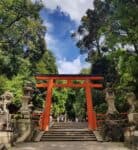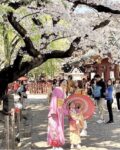Japanese culture has hugely intrigued Western people and people from other eastern countries alike for as long as anyone can remember. Many of us incorporate aspects of the culture into our everyday lives, sometimes without even being aware of it. Why is this? What makes Japanese culture so captivating to the rest of the world and why is it considered to be so unique?
Japan is authentic and full of culture, as are many countries in the world. But the thing that makes Japanese culture so unique and fascinating might be the fact that the Japanese have the ability to blend their rich history and culture into modern-day traditions.


What is Unique About Japanese Culture?
Traveling to Japan is definitely an experience like no other. Everything is clean (really, perfectly clean), everything works, the people are very friendly and the level of technology is out of this world. However, Japan is a lot more than just a highly modern and business-like first world country. Japan is very rich in culture, celebrations, and traditions too.
The Food
This one might sound slightly obvious and stereotypical, but not many people realize how special Japanese cuisine really is. The Japanese have successfully proven that however strange or foreign certain foods may seem to people in the west, it is still really good.
Japanese cooking is known as “washoku” and is based on “the rules of 5”. The five rules mean using five flavors, five colors, and five cooking methods when cooking a full course meal. A full course meal in Japan consists of a soup and three sides, which is paired with rice.
This means that not only is the food totally delicious because of all the flavors, but it also looks beautiful because of all the colors. The food is mostly low in calories and fresh products are almost always used, which means that on top of all the other benefits, it is very healthy as well.
Japanese food is undoubtedly one of the most unique cuisines in the world. There is a lot more to it than just sushi, sashimi, and sake. Here are some examples of less famous but more traditional Japanese dishes:
- Kushikatsu

Kushikatsu comes from Osaka and is also called kushiage. This dish consists of deep-fried, skewered meat. Anything from chicken and pork to beef and seafood is used to make it and it is always served with a dipping sauce.
- Okonomiyaki
Pancakes are a staple in many countries throughout the world, but Japan has its own unique take on them. Okonomiyaki is a savory Japanese pancake. This dish is loved throughout the country and considered soul food. It consists of meat and vegetables that are mixed into a batter and fried. This is definitely a unique version of classic pancakes.
- Butaniku no shogoyaki
Butaniku no shogoyaki is pork dipped in a ginger sauce. The sauce is what makes the dish stand out because it consists of ginger, soy sauce, sake, sliced onions, granola oil, and mirin. This is a diverse dish and people can buy it anywhere from fine dining restaurants to fast-food chains and grocery stores.

Bento boxes are not just cool names for kids school lunchboxes. Bento originated in Japan and is almost 1000 years old. It was created for men to be able to carry lunch to work. A bento box is literally a box that can be made from several materials (mostly wood, plastic, or bamboo) and contains a large variety of foods.
Many Japanese people have kept this tradition going and still use these boxes to pack lunch for work or school. A bento box can literally consist of anything (meat, rice, vegetables, miso, etc.) and will usually stick to the rule of 5. It is full of flavors and very colorful.
People
What is a country without its people? Japanese people are definitely one of the biggest reasons why their country is described as so unique. The people are generally known to be particularly polite, kind, and hard-working. Most people who travel to Japan seem to comment on how friendly and welcoming the Japanese are toward tourists.
It seems that Japanese people are likely to be more polite and respectful than people in other countries. Why is this?
- Religion
The main beliefs in Japan are based on a mixture of the teachings of Confucious and the Shinto religion. The primary teachings of these 2 religions are that followers should be incredibly respectful of other people and that they should strive to do good and be good people.
Even though most of the people from newer generations do not usually classify themselves as either Shintoists or Confucianists, the teachings of both these religions play an important part in Japanese society. The basic principles of kindness and respect are taught to children from a young age.
- Large Population

Think about it. If millions of people live in very close proximity to each other and each one did whatever they wanted, regardless of the feelings of the people around them, it would be a nightmare.
In a way, because of this, Japanese people have to be respectful. To live in such a densely populated society, you have to be mindful of others.
- Culture Rules
Japanese culture is big on perfectionism. Adding to this, there is a very faint line between what is right and what is wrong. These rules of society are taught from a young age and are second nature to the people of Japan. Most westerners often find it incredibly difficult to integrate into Japanese society because of this. But, these rules play a very important role in keeping a harmonious society.
The way they come across to their fellow citizens is also important to the Japanese. There is a pecking order and older people, or people who are in a position of authority should be treated more formally than say, someone your own age or someone who works for you.
For example, there are different ways to say thank you to different people. An older, highly respected person should be bowed to in a different way that is seen as more formal.
The Language
The Japanese language is very, very different from other languages. As I mentioned before, politeness is a very big part of Japanese culture, and this can be shown in the language.
A good way to describe it is to say that there are three different levels of politeness in the language – teinego(formal), keigo (highly formal), and kudaketa nihongo (informal). What decides the level of politeness that should be used is a person’s ‘rank’ or how familiar you are with them.

Children, students, employees, etc. are considered to be lower ranks and they are usually spoken to informally. Guests, customers, parents, bosses, and the elderly are considered higher ranks and they are spoken to formally.
Keigo is used to speak to people who are seen as very important and respected such as businessmen and women, or the elite.
In English, if we want to sound more formal or show respect, we simply change our word to sound that way. In Japanese, it’s more about changing your grammar, tone, and using different verb forms.
For kudaketa nihongo, the Japanese use plain verb forms. For teinego, they use polite verb-endings and for keigo, they use respectful verb forms.
This may all sound very complicated and to someone who has never learned to speak the language, it most likely is. Japanese really focuses a lot on politeness as well as how respectful you should sound to who. Not doing this can come across and rude and disrespectful. There are many rules to keep in mind and this is what makes it such an interesting, unique language.
Celebrations
- Bonenkai and Shinnenkai
Bonenkai and shinnenkai are traditional new year celebrations in Japan. Bonenkai is the celebration of the end of the year and shinnenkai is the celebration of the new year.
In comparison to western countries that celebrate both these events as one, these two basically happen in the same time frame, but both parties are held for a different reason. Both of these events involve drinking alcohol.
- Valentines Day and White Day

In Western culture, men and women give each other gifts to show their love for each other. You could even say that the focus is mainly on women receiving gifts from their significant others.
In Japan, Valentine’s Day – also celebrated on February 14th – is meant for men only. Girls and women give typical gifts (usually chocolate) to the men. White Day is exactly one month later on 14 March and this is the day where men buy gifts for women.
- Baby crying festival
The baby crying festival takes place in April each year at the Sensoji Temple in Tokyo.
This is definitely a strange festival to have since most people do what they can to make their babies stop crying. But here, parents do what they can to actually make their babies cry.
The babies are given to sumo wrestlers who have to make them cry. Whoever cries the most and the loudest, wins the competition.
Parents bring their babies to the crying festival to rid them of any potential demons that might cause unhappiness in the future. It is an ancient Japanese belief that screaming loudly will drive demons away.
- Laughing Festival (Nyu Matsuri / Warai Matsuri)

This festival takes place at the NYU Shrine in Hidakagawa on the second Sunday of October every year. It follows the 200-year-old story of the goddess Niutsuhime who was laughed at for oversleeping and became very sad. The village people cheered her up by making her laugh and this is still celebrated today.
On this day, a bell jingler dresses up like a clown and leads dancers in a parade. While they are performing, dancers shout “warae, warae” which means “laugh, laugh.
Architecture
Japanese architecture is considered to be one of the most unique styles of architecture in the world. It is not only because of how different and beautiful it looks, or how old many of the buildings are, but it is because Japan has been able to design modern buildings while still keeping alive the basic principles of ancient Japanese design.
Japan’s architecture is very captivating to look at. It is not only limited to the buildings but can even be seen in Japanese gardens and parks. A lot of effort is put into creativity and careful planning is used to make architecture looks more like giant displays of fine art than just ordinary buildings.

Most building and architecture is based on the principals of Shintoism, Buddhism, and Confucianism. A lot of designs are based around spirits and nature.
The reason that their architecture looks the way it does is because of many factors like religion, philosophy, and geography. Buildings have to be strong to withstand things like earthquakes and tsunamis, which everyone knows are common in Japan.
Maybe the most interesting point is that everything is designed to be simple and minimalistic, but still unique and breathtaking. This is very difficult to complete and yet the Japanese do such a good job of it.
Samurai Culture
Samurai culture may seem like just another part of Japanese culture, but it has actually played a very big role in shaping Japan. To some extent, the discipline that was so important in samurai can still be seen today.

Bushido or “the way of the warrior” is a very old philosophy, but it meant living a life of bravery and honor. Even though modern-day Japanese people no longer fight actual battles, to them, this way of life is still applicable in their everyday situations. It is important for them to handle situations with dignity and pride and to bring honor to themselves and their families.
Japan is definitely proud of their samurai history and it is still a very big part of Japanese culture. There are many heritage and memorial sites all over Japan that are dedicated to samurai warriors and the battles that they fought.
But, their pride is not only seen in the museums, statues, and historic battle sites. It can be seen in other things too. The amazingly designed gardens, the countless history books and stories that are preserved, and certainly the lifestyle of the people.
Anime and Manga
Whether you are a fan or not, the chances are good that you know what anime and manga are. This incredible Japanese art form is one of the things that has gained the attention of people all around the world.
The difference between anime and manga is that manga refers to the traditional comic books and anime refers to the animation and motion versions of these books. In simple terms, manga is the books and anime is the show.

The word “manga” is literally translated into “whimsical comics”. There is a type of manga for every single person out there. Whether you are a child, a teenage girl, a teenage boy, an adult male or an adult female, and whether you like crime, sci-fi, horror, romance, etc, there is a manga comic out there for you.
Manga is really old and is said to have originated as early as 1603. This is a very big and unique part of Japanese culture, because of the distinctive way of writing and the interesting storylines.
Anime may not be as old as manga, but it has been created and based on manga since around 1917. Anime can be described as Japanese cartoons. The illustration and the way the characters are drawn are really distinct and creative and there is nothing quite like it.
It is a very popular form of entertainment worldwide, especially in America and European countries. Shows like Dragon Ball and Pokemon have become household names.
How Has Japanese Culture Changed Through The Years?
Honoring traditions is a very important thing in Japan but, as with any country, they have modernized many of their traditions.
What makes Japan unique is that instead of doing away with old traditions, they simply changed them to fit into modern society.
Some examples can be seen in:
Fashion
The Japanese used to believe that wearing a lot of clothing shows everyone that you are rich. Having tattoos and showing a lot of skin was seen as offensive. Today, the latter perception is still true. Some people still enjoy wearing traditional clothes such as kimonos and hakama. Outfits have evolved and become more casual and edgy, but they are generally still quite modest.
Entertainment
In older Japanese culture, people used enjoyed theatre arts as entertainment. Geishas were also very popular.
Geishas can still be found today and even though they are not as common as in the past, the Japanese still value this important part of their history.

Modern-day entertainment in japan consists more of anime and gaming. Because Japan is so technologically advanced, electronics can be seen as the main source of entertainment.
What Is Japanese Philosophy?
How do you explain why one country is filled with millions of hard-working and respectful citizens who want to live together peacefully, incredibly beautiful and interesting architecture that can withstand the strongest forces of nature and rich cultural and traditional aspects that have made their way into the hearts of people all around the world?
The only way that a country could be this way is if these important principles have been in place since the beginning of time.
The Japanese are strict and disciplined, but at the same time, they are fun and friendly. This is a balance that many people wish to achieve throughout their lives.
One of the most important philosophical concepts in Japan is that of honne and tatemae. Honne means the inner self, while tatemae means the outer self. Honne is what you feel on the inside – who you really truly are. Tatemae is the acceptable side you show the world. Many times, there will be a battle between these two. To live in harmony with other people, tatemae must win.
Politeness and living in harmony are what make Japanese society the way it is. The Japanese believe that people are all different and individuals (honne) and that that is okay. But, for society to function in the most optimal way and out of respect for others, people should act in a way that is acceptable to everyone (tatemae).
People are usually discouraged from expressing their emotions in public or in group settings. They are also expected to be able to read situations well and react accordingly. This concept is known as joushiki, which literally means “common sense”.
These concepts play a huge part in why some western people might think that the Japanese come across as cold or emotionless. It is because, in western society, we are encouraged to express our feelings and be loud. In Japanese culture, it is seen as better to conform to keep peace in society.
It may seem hard to understand for people from other countries, but this is what keeps Japanese society the way it is. This is the reason why Japanese people are seen as grateful, friendly, and polite.
Conclusion
Japan is a very modern, fast-paced country, yet it still keeps a lot of its ancient traditions alive. There are strict rules and sometimes controversial ways of doing things and even though we know so much about this country, there is still a mysterious aura around Japan.
However, this sense of mystery is what makes it so unique and enchanting. Japan has successfully created what is referred to by many as “the perfect society”.
But, Japanese culture is more than that. It is filled with different tastes, colors, celebrations, amazing designs, fantastic entertainment, and a history filled with countless stories of honor, love, and battles. If Japan were a book, it might be a very long one, but it would also be one that you just can not put down.




























